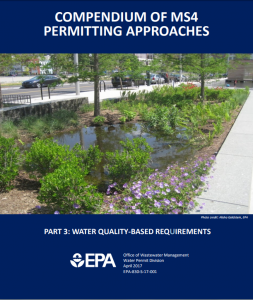In June, the U.S. Environmental Protection Agency (EPA) released the third part of its ongoing Municipal Separate Storm Sewer System (MS4) Permit Compendium Series. The 47-page report presents examples of permit language used by MS4 managers from around the country to create site-specific regulatory criteria that either supplement or supersede the use of total maximum daily loads (TMDLs).
Under the Clean Water Act, waters labeled “impaired” are subject to strict limits on the maximum amount of pollutants that can enter the waterway legally in a day. TMDLs are particularly important to help guide stormwater management goals and coordinate collective action.
For local, state, and federal water quality permitting authorities, sometimes, the “one-size-fits-all” solution of TMDLs is not sufficient to promote protection of these waterways. Likewise, for stormwater managers, navigating the complex landscape of which TMDL limits apply and where can be dizzying.
EPA crafted the compendium to give permitting authorities ideas for alternative ways to meet water quality goals specific to unique challenges and characteristics of different MS4s, with emphasis on making permitting regulations “clear, specific, and measurable,” the report reads.
Among the alternate regulatory models the report suggests are
- distributing in-depth tables indicating which in-state MS4s are affected by each TMDL value;
- implementing pollutant-specific regulatory parameters, or specific control measure requirements for pollutants of concern;
- allowing MS4 permit-holders to build compliance plans with review and approval from authorities; and
- requiring MS4s to monitor progress toward broad water quality goals and model the effects of stormwater interventions on waterway quality.





